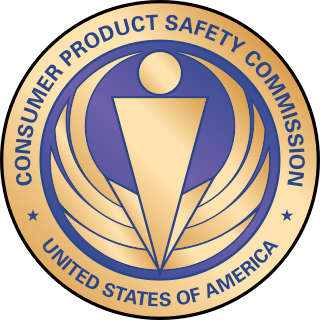
Choking, also known as foreign body airway obstruction (FBAO), is a phenomenon that occurs when breathing is impeded by a blockage inside of the respiratory tract. An obstruction that prevents oxygen from entering the lungs results in oxygen deprivation. Although oxygen stored in the blood and lungs can keep a person alive for several minutes after breathing stops, choking often leads to death.

A child harness is a safety device sometimes worn by children when walking with a parent or carer. Child harnesses are most commonly used with toddlers and children of preschool age, though they may also be used with older children, especially if they have special supervisory needs such as ADHD or autism. Various types exist, though all are worn by the child and have a lead (tether) or rein which is held by a parent or caregiver. As child harness designs and purposes have evolved with cultural norms and parenting techniques, they have become subject to common debate.
Co-sleeping or bed sharing is a practice in which babies and young children sleep close to one or both parents, as opposed to in a separate room. Co-sleeping individuals sleep in sensory proximity to one another, where the individual senses the presence of others. This sensory proximity can either be triggered by touch, smell, taste, or noise. Therefore, the individuals can be a few centimeters away or on the other side of the room and still have an effect on the other. It is standard practice in many parts of the world, and is practiced by a significant minority in countries where cribs are also used.

Babywearing is the practice of wearing or carrying a baby in a sling or in another form of carrier. Babywearing has been practiced for millennia around the world. Babywearing is a form of baby transport which can be used for as long as mutually desired, often until toddlerhood and beyond. In the industrialized world, babywearing has gained popularity in recent decades. Part of the reason for this shift is due to the influence of advocates of attachment parenting.

The United States Consumer Product Safety Commission is an independent agency of the United States government. The CPSC seeks to promote the safety of consumer products by addressing "unreasonable risks" of injury ; developing uniform safety standards ; and conducting research into product-related illness and injury. In part due to its small size, the CPSC attempts to coordinate with outside parties—including companies and consumer advocates—to leverage resources and expertise to achieve outcomes that advance consumer safety. The agency was created in 1972 through the Consumer Product Safety Act. The agency reports to Congress and the President; it is not part of any other department or agency in the federal government. The CPSC has five commissioners, who are nominated by the president and confirmed by the Senate for staggered seven-year terms. Historically, the commission was often run by three commissioners or fewer. Since 2009, however, the agency has generally been led by five commissioners, one of whom serves as chairman. The commissioners set policy for the CPSC. The CPSC is headquartered in Bethesda, Maryland.

Various methods of transport of children have been used in different cultures and times. These methods include baby carriages, infant car seats, portable bassinets (carrycots), strollers (pushchairs), slings, backpacks, baskets and bicycle carriers.

A baby walker is a device that can be used by infants who cannot walk on their own to move from one place to another. Modern baby walkers are also for toddlers. They have a base made of hard plastic sitting on top of wheels and a suspended fabric seat with two leg holes. In the US, baby walkers are responsible for about 2000 injuries annually to children serious enough to require a trip to the emergency room, prompting calls from pediatricians for their outright ban.

An infant bed is a small bed especially for infants and very young children. Infant beds are a historically recent development intended to contain a child capable of standing. The cage-like design of infant beds restricts the child to the bed. Between one and two years of age, children are able to climb out and are moved to a toddler bed to prevent an injurious fall while escaping the bed.

A playpen is a piece of furniture used to contain an infant or young toddler in specific area to prevent the child from getting into harm when her/his parent or guardian is occupied or away while keeping the child occupied with the toys which can be placed inside. The earliest use of the word "playpen" was cited in the Oxford English Dictionary is 1902.

Childproofing is the act of making an environment or object safe for children. This reduces risks to a level considered acceptable by a society, an institution, or to specific parents. Childproofing may include restriction of children to safe areas or preventing children from reaching unsafe areas. This can be accomplished by the parent or by hiring a professional for assistance. Childproofing is gaining more prominence now that parents have greater access to information on child injury and a wide variety of products are available to help prevent it. It has become so top-of-mind for parents that even hotels and child-friendly resorts are offering "child-proof" rooms.

A bassinet, bassinette, or cradle is a bed specifically for babies from birth to about four months. Bassinets are generally designed to work with fixed legs or caster wheels, while cradles are generally designed to provide a rocking or gliding motion. Bassinets and cradles are distinguished from Moses baskets and carry cots, which are designed to be carried and sit directly on the floor or furniture. After four months, babies are often transferred to a crib or cot. In the United States, however, the bedside sleeper is the prevalent option, since they are generally bigger, recommended up to 6 months, and often used up to a year.

Gross motor skills are the abilities usually acquired during childhood as part of a child's motor learning. By the time they reach two years of age, almost all children are able to stand up, walk and run, walk up stairs, etc. These skills are built upon, improved and better controlled throughout early childhood, and continue in refinement throughout most of the individual's years of development into adulthood. These gross movements come from large muscle groups and whole body movement. These skills develop in a head-to-toe order. The children will typically learn head control, trunk stability, and then standing up and walking. It is shown that children exposed to outdoor play time activities will develop better gross motor skills.
The Kind + Jugend Innovation Award is a German design award granted annually to the best overall baby product in the areas of design, safety, user-friendliness, degree of innovation, and quality of workmanship. Particular emphasis is placed on innovation and safety, with past winners displaying unique designs and new technology.

Harvey Neil Karp, FAAP is an American pediatrician, author, and child development specialist. He is best known for his book "The Happiest Baby on the Block" and its accompanying DVD, that use his "5 S's" approach to infant care. He is also the creator of the Snoo, a smart bassinet.

Headquartered in Boston, Massachusetts, Evenflo Company, Inc. operates the juvenile travel and home safety businesses with products that include car seats, travel systems, safety gates, high chairs, play yards, stationary activity centers, infant carriers and doorway jumpers. Evenflo Company Inc. has two manufacturing facilities: one in Piqua, Ohio, and one in Tijuana, Mexico.

A travel cot is a bed for use by a baby or young child that collapses or folds into a bag for easy carriage. Travel cots are typically much lighter than a standard cot, with soft sides to provide comfort to the baby when sleeping.

A bedside sleeper, also referred to as a sidecar sleeper or bedside bassinet, is a bassinet or baby cot that attaches to the parents' bed, allowing newborns to sleep next to their parents safely. This is a form of safe co-sleeping, and has little risks associated with sudden infant death syndrome, unlike bedsharing. Bedside sleepers are a component of rooming-in, a practice followed in hospitals to keep the baby by the mother's bed, giving her time to establish a stronger bond with her baby.
Infant and toddler safety are those actions and modifications put into place to keep babies and toddlers safe from accidental injury and death. Many accidents, injuries and deaths are preventable.
Newborn care and safety are activities and precautions recommended for new parents or caregivers. It is an educational goal of many hospitals and birthing centers to promote newborn care and safety as parents take their infant home.






















